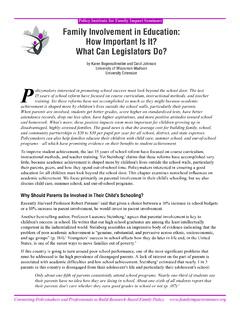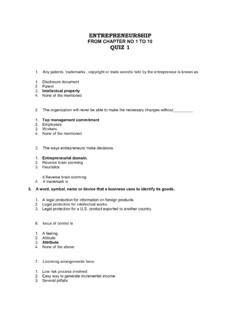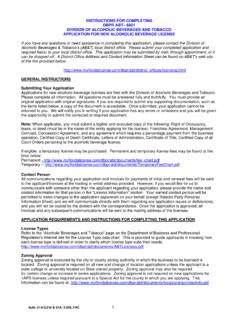Transcription of A Landowner’s Guide to the Wetlands Reserve Program (WRP)
1 A Landowner s Guide to theWetlands Reserve Program (WRP) MassachusettsJuly 2011 Helping People Help the is an equal opportunity provider and employer. NELSONCATHERINE ULITSKYLIZ WILLEYDIANE PETIT, NRCSA Landowner s Guide to the Wetlands Reserve Program (WRP)2 MassachusettsAre you ready for WRP?You must have owned the land for at least seven years prior to offering your land for a WRP easement, unless the land was inherited or you can prove that the land was not obtained for the purpose of enrolling it in the be aware that it is the landowner s responsibility to provide clear title and written, recordable access rights to the proposed easement.
2 If the proposed easement area is only accessible by crossing a third party s property, an access agreement or other documentation must be in place prior to application. Land enrolled in WRP is ineligible for other usda Program payments for the life of the easement. Any existing cropland base and allotment history for enrolled acres will be permanently retired at the time the easement is recorded. We recommend that you and your leasee (if applicable) contact your local FSA and NRCS field office to determine how enrollment in WRP will impact your other Program and Restoration AgreementsWhen you apply for WRP, you have three enrollment options: a permanent easement, a 30-year easement or a restoration agreement.
3 An easement is a real estate transaction. You, the landowner, will continue to control access to the land. Permanent Easements - This is a conservation easement in perpetuity. The easement payment will be the lesser of: the fair market value of the land determined by a Uniform Standards of Professional Appraisal Practice (USPAP) appraisal or area wide market analysis, an established payment cap, or an amount offered by the landowner. In addition to paying for the easement, usda pays 100 percent of the costs of restoring the Easements - This is a conservation easement lasting 30 years.
4 Easement payments are 75 percent of what would be paid for a permanent easement. usda also pays 75 percent of restoration Agreements - This is an agreement (generally for a minimum of 10 years) to reestablish degraded or lost wetland habitat. usda pays 75 percent of the cost of the restoration activity. This does not place an easement on the property. The landowner provides the restoration site without Most applicants will need an attorney to clear the title to the land. We recommend that you contact your attorney and accountant for legal and financial advice specific to your situation prior to applying for are responsible for legal and accountant fees to clear of ContentsIntroduction.
5 2 Are you ready for WRP? ..2 Easements and Restoration Agreements ..2 Key Points ..3 Restrictions ..3 Compatible Use Permits ..3 Landowners rights ..4 The WRP application package ..4 WRP application materials ..4 The application ranking process ..4 WRP enrollment process ..5 Closing the deal ..5 Failure to convey the Recovery ..5 Monitoring WPR easements ..5 Glossary - Commonly Used Real Estate Transaction Terms ..6 Landowner s Checklist ..6 Questions and Answers ..7 WRP Planning Guide ..8 Contact us ..8 IntroductionThank you for your interest in protecting and enhancing Wetlands on your land through the Wetlands Reserve Program (WRP).
6 WRP is a voluntary Program that provides technical and financial assistance to private landowners to protect, restore and enhance Wetlands in exchange for retiring eligible land from agriculture. Depending on the type of easement or agreement you enter into with NRCS, compensation may be available for all or part of the cost of conservation practices that will improve wildlife habitat and restore natural Guide will help you understand the WRP application process, how applications are ranked and selected for funding, as well as your responsibilities as a WRP participant.
7 Your local NRCS field office can provide you with additional information and application documents, and answer Landowner s Guide to the Wetlands Reserve Program (WRP)MassachusettsKey Points About WRPO ther important points: 6 WRP funding is allocated annually and is, therefore, limited. Not all applications will be selected for funding. 6 Applications are ranked competitively. 6 All paperwork and documentation must be complete before NRCS will begin processing an application. 6A WRP easement is a permanent or long term commitment that has significant restrictions.
8 It is important that you completely understand the terms and conditions of the easement. Please take the time to discuss your enrollment with an NRCS representative. 6 When you file an application for a WRP easement or restoration agreement, you are volunteering to limit future use of offered acres, but will retain private ownership. 6 Read all Program information carefully to determine if you are ready to apply for restrictions associated with a WRP easement include: XPermanent structures of any kind are not allowed on the easement area.
9 Any existing structures must be removed at the landowner s expense prior to the recording of the easement. This includes structures like sheds and pump houses. Hunting blinds that are removed at the end of the season are allowed. XAccess roads within an easement boundary are not guaranteed to remain functional or passable. In some instances, they may be allowed to remain with a compatible use permit. When selling the property, however, these internal roads or trails should not be defined as permanent vehicle access.
10 XActivities such as cutting vegetation or harvesting wood products will require a compatible use permit. Compatible uses are allowed only if they are fully consistent with the protection and enhancement of the wetland. See the Compatible Use Permits section of this Guide for more are additional restrictions. Be sure to discuss these with your NRCS Use PermitsLandowners may request compatible use permits for certain uses. Any activity that affects vegetation, hydrology, or alters wildlife patterns requires a compatible use permit.



















